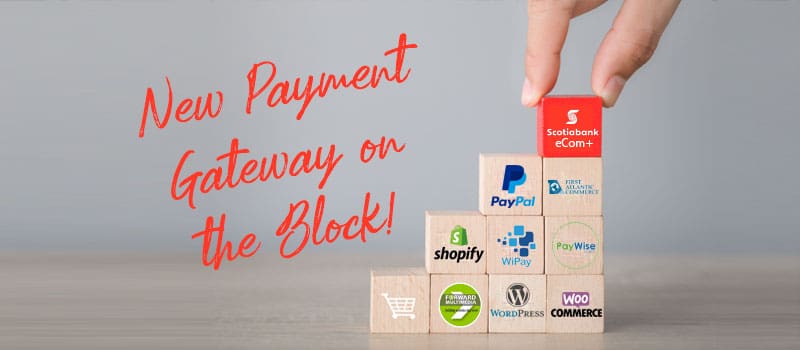Updated October 1st, 2022
New Payment Gateway! Scotiabank eCom+™
In a clear signal that local E-Commerce is steadily marching forward, Scotiabank has introduced it’s very own payment gateway called Scotia eCom+™. It’s the first direct competitor to the First Atlantic Commerce (FAC), which has been the only similar option available in Trinidad & Tobago.
While FAC will still be available from Scotia, and of course all other banks, it will be an interesting competition. FAC dominated for years being the only game in town, and I’ll hasten to add that FAC never flexed their muscles for this one iota; they’ve always remained the consummate professionals, very responsive, supportive and customer friendly. However, if Scotiabank gets it right, it will all boil down to price.
How Scotia eCom+™ works
Scotiabank’s new online payment solution is a bona fide payment gateway, in that it can be integrated with your shopping cart for seamless checkout experience. It can also be used as a standalone payment portal, i.e. without integration, by redirecting customers from your website to their secure payment platform by embedding their payment form into your website.
Scotia eCom+™ integrated with your shopping cart
Scotia eCom+ can be integrated with most popular shopping carts once they are open source or provide access. Forward Multimedia already has live online stores on the WordPress/WooCommerce platform, such as Royal Bengal Trading, which was one of the very first integrations in the country, and on the Lightspeed platform on Cost Savers. In progress are integrations with Shopify which will make it 3 different platforms.
Scotia eCom+ uses the same Hosted Payment Page (HPP) method of integration like FAC where the customer is redirected away from the online store’s checkout page to a different URL to enter credit card details, and then redirected back to the online store for the standard on-screen ‘success’ confirmation. The customer also gets the standard email confirmations and the merchant gets their standard email notification emails as well.
Scotia eCom+™ accept payments via payment link
This lets you accept credit card payments without any integration via a payment link. It’s the budget solution when you don’t have (or want) an E-Commerce website where you simply want to get paid, end of story. Republic Bank already offers a similar option via their Republic EPay solution, and so too does WiPay. You can send the link to your customer via email, Whatsapp, get your money and you’re done.
Scotia eCom+™ offers USD currency option
All other local banks provide only TTD currency support even if you’re earning USD from transactions using non-TT credit cards. However, with Scotiabank’s Scotia eCom+, there is the option to keep your USD, which makes it a more attractive solution. As we are all painfully aware, the lack of USD in Trinidad & Tobago is an ongoing headache, and all signs are that it will continue indefinitely as long as the worldwide economic challenges remain… and if local challenges remain as well— especially exacerbated by the 41 donkeys you put in the Red House.
Scotia eCom+™ is cheaper than FAC
I can’t divulge actual costs here except to say that the monthly cost of this solution is less than half of the cost of First Atlantic Commerce. And to be fair, the costs banks charge are per their internal cost structures based on their licensing agreements with FAC.
Note that the bank fees involved with any online payment solution may comprise:
- Set-up fee (one time, and sometimes waived)
- Processing fee (from 3% of order value and up, negotiable in some cases)
- Transaction fee (from $1.75 TTD per transaction and up
- Monthly maintenance fee ( from $25 USD up to $100 USD/mth)
Also note that the above fees are between you and your bank and sometimes subject to negotiation and your business relationship. Forward Multimedia’s integration fee is separate.
Scotia eCom+™ requires an account with Scotiabank
While I assume this should go without saying, I say it for completeness. If you’re already a Scotiabank customer, whether personal or business, then the process to obtain this solution would require less steps being already in their system. If you don’t have a business account with Scotiabank, then you’ll have to go through the necessary paperwork to open an account, after which you’ll be able to apply for the payment gateway.
And we’re also painfully aware of the nightmare that is paperwork required to open a bank account in Trinidad & Tobago which I anticipate down the road will not be complete without fingerprinting and scans of your backside.
Scotia eCom+™ maximum fraud protection is 3DS 2.0
I mention this to compare with First Atlantic Commerce’s additional fraud protection service called Kount. At the moment, fraud support when entering credit card details uses 3D Secure 1. However, some time before the end of 2022, both Scotiabank eCom+ and FAC will have to support the latest version called 3D SECURE 2.0, which introduces a new feature called Frictionless Flow which is perhaps the biggest improvement made to this 16 years old protocol. By performing risk-based authentication in the access control server (ACS), issuers are now able to approve a transaction without the need for input from the cardholder.
From what I see, this is similar to Kount, which also performs a risk analysis profile of the user. With Kount activated, credit card transactions can be rejected with a response code of ‘Suspected Fraud’. However, the Kount service is at a cost for the additional protection, so it would seem that the 3DS version 2 offers better protection by default, which was one of my concerns with 3D Secure 1.
UPDATE: 1ST OCT, 2022: Please note that the support of the 3DS authentication lies with the individual banks not FAC alone. As of October 1st, 2022, for Forward Multimedia FAC integrations, Republic Bank is only bank to upgrade to 3DS2, and all my FAC/Republic Bank clients have been so upgraded. Also note RBC Royal Bank does not support 3DS and First Citizens Bank (FCB) is not ready with 3DS2 so merchants will have to wait for now.

What’s different with 3D Secure 2
For businesses, the benefit of 3D Secure is clear: requesting additional information lets you build in an extra layer of fraud protection and ensure that you only accept card payments from legitimate customers. As an added incentive, authenticating a payment with 3D Secure shifts the liability for chargebacks due to fraud from your business to your customer’s bank. This added protection is why 3D Secure is often applied to large purchases like airline tickets.
Unfortunately, the use of 3D Secure 1 also has some drawbacks: the additional step required to complete the payment adds friction to the checkout flow and can lead customers to abandon the purchase. Additionally, a number of banks still force their cardholders to create and remember their own static passwords to complete 3D Secure verification. These passwords are easy to forget, which can lead to higher rates of cart abandonment.
EMVCo, an organization made up of six major card networks, released a newer version of 3D Secure. 3D Secure 2 (also called EMV 3-D Secure, 3D Secure 2.0 or 3DS2) aims to address many of the shortcomings of 3D Secure 1 by introducing less disruptive authentication and a better user experience. (Source: Stripe)
UPDATE: 1ST OCT, 2022: Support of 3DS1 will cease as of October 15th, 2022 for Visa on October 18th, 2022 for Mastercard. This means that after these dates, non 3DS2 enrolled cards will be processed via standard authentication via card number, expiration date and CVV and NOT 3DS1.
What this means for fraud: It means a lot. Locally issued credit cards have to be enrolled in 3DS2 first to be authenticated when your customer pays online on Scotia eCom+ or FAC payment pages.

Forward Multimedia's Scotia eCom+™ plug-in
Forward Multimedia, via a partnership, has developed a WordPress plugin that interfaces with the Woo Commerce system, as well as plug-ins that work with the Lightspeed and Shopify platforms The plugin acts like a Payment Gateway and can be configured to work with any Payment Provider. This plugin has been configured to work out of the box with Scotia eCom+.
Our plug-in is available only for our clients where we do the installation, configuration and provide support. It’s therefore NOT an à la carte ‘off-the-shelf’ plug-in for sale.
Conclusion
Thanks to the pandemic, online payment offerings are only going to increase in Trinidad & Tobago as local E-Commerce continues its upward trend. Trinis are not only open and receptive to online shopping now, but also treat it as standard, and are actually surprised if merchants don’t provide some form of online commerce— even the lowly online bank transfer option. I expect more banks to follow Scotia’s lead and come up with their own branded solutions.
You may learn more about the solution on Scotiabank’s website here.



This is great. LOVE the article, information and the digs. Did I say great article! I’m experiencing problems receiving money from clients via PayPal. My mastermind.com site became unworkable because I connected Paypal to debit card.
And no, I don’t have an account with Scotia. Don’t they usually ask for confirmation of deaths and births going all the way back to… yes, my one interaction with Scotia years ago.
So tell me, how could I make this payment gateway work for me and my clients abroad? I sell consult services woo-woo stuff to you, everything is online. In the process of creating something in Aweber however I have to point my clients to where they can pay.
How can any of the options you mentioned above help (leaving Scotia aside for now). And by the way never heard of FAC until today while researching.
Hope to hear back.
Cheers
Lol on the detailed family tree requirement Catherine, that’s now replaced with a standard blood sample, ha. I’ll have to check the site to confirm it’s payment set-up requirements as generally it doesn’t matter if the connected card is debit or credit. I say this because I have debit card connected to a PayPal account and there’s never been an issue. Is the PayPal account linked to a T&T issued debit card?
The simplest way to collect payments from clients abroad would be without any website integration, using say Republic Bank’s Epay or Scotiabank’s eCom+, and even WiPay or PayWise. All have simple methods of creating payment links you can send via email, whatsapp etc. The only issue is that they won’t be tied to an order, you’ll have to manually mark as paid, or just keep track.